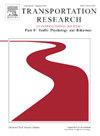Exploring driver decision-making in lane-changing: A human factors approach using AI and naturalistic data
IF 4.4
2区 工程技术
Q1 PSYCHOLOGY, APPLIED
Transportation Research Part F-Traffic Psychology and Behaviour
Pub Date : 2025-07-07
DOI:10.1016/j.trf.2025.06.030
引用次数: 0
Abstract
Anticipating lane-change patterns represents a crucial dimension within the intricate framework of lane-change decision-making, exerting a profound influence on the fluidity of traffic dynamics and the overarching spectrum of road safety. Previous studies have mostly focused on fixed sections of highways, missing the changing and complex traffic patterns that drivers experience throughout the entire highway journey. This study explores the behavioural dimensions of lane-changing by leveraging an innovative data collection approach using cost-effective 3D LiDAR technology integrated into an instrumented vehicle platform. This system enables real-time, high-resolution data capture under diverse driving conditions, including nighttime and low-visibility scenarios. The study introduces the Expressway Drive Instrumented Vehicle (EDIV) Dataset, which captures naturalistic driving behaviour from 60 drivers over approximately 8,100 km on Indian expressways. Beyond the mere prediction of drivers’ lane-changing events, the research delves deeper into the intricate composition of lane transitions, employing a sophisticated repertoire of Machine Learning (ML) methodologies. Notably, the Extreme Gradient Boosting (XGBoost) technique emerges as the preeminent contender, showcasing better efficacy in accordance with classification metrics. Culminating in the application of elucidatory Artificial Intelligence (AI) paradigms, such as SHapley Additive exPlanations (SHAP) values, to interpret the intricacies of XGBoost-derived insights into driving behaviour. By integrating human factors research with data-driven methodologies, this study contributes to the development of safer and more behavioural informed traffic systems in mixed traffic environments.

探索驾驶员在变道中的决策:使用人工智能和自然数据的人为因素方法
在变道决策的复杂框架中,预测变道模式是一个至关重要的方面,对交通动态的流动性和道路安全的总体范围产生深远的影响。以前的研究主要集中在高速公路的固定路段,而忽略了驾驶员在整个高速公路旅程中经历的变化和复杂的交通模式。本研究通过将具有成本效益的3D激光雷达技术集成到仪表化车辆平台中,利用创新的数据收集方法,探索了变道行为的维度。该系统可在各种驾驶条件下(包括夜间和低能见度场景)实现实时、高分辨率数据捕获。该研究引入了高速公路驾驶仪表车辆(EDIV)数据集,该数据集捕获了60名司机在印度高速公路上行驶约8100公里的自然驾驶行为。除了单纯预测驾驶员变道事件之外,该研究还采用了复杂的机器学习(ML)方法,深入研究了车道转换的复杂组成。值得注意的是,极端梯度增强(XGBoost)技术成为了最优秀的竞争者,根据分类指标显示出更好的效果。最终应用解释性人工智能(AI)范式,如SHapley加性解释(SHAP)值,来解释xgboost衍生的驾驶行为见解的复杂性。通过将人为因素研究与数据驱动方法相结合,本研究有助于在混合交通环境中开发更安全、更有行为信息的交通系统。
本文章由计算机程序翻译,如有差异,请以英文原文为准。
求助全文
约1分钟内获得全文
求助全文
来源期刊
CiteScore
7.60
自引率
14.60%
发文量
239
审稿时长
71 days
期刊介绍:
Transportation Research Part F: Traffic Psychology and Behaviour focuses on the behavioural and psychological aspects of traffic and transport. The aim of the journal is to enhance theory development, improve the quality of empirical studies and to stimulate the application of research findings in practice. TRF provides a focus and a means of communication for the considerable amount of research activities that are now being carried out in this field. The journal provides a forum for transportation researchers, psychologists, ergonomists, engineers and policy-makers with an interest in traffic and transport psychology.

 求助内容:
求助内容: 应助结果提醒方式:
应助结果提醒方式:


